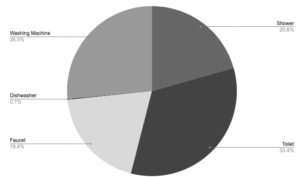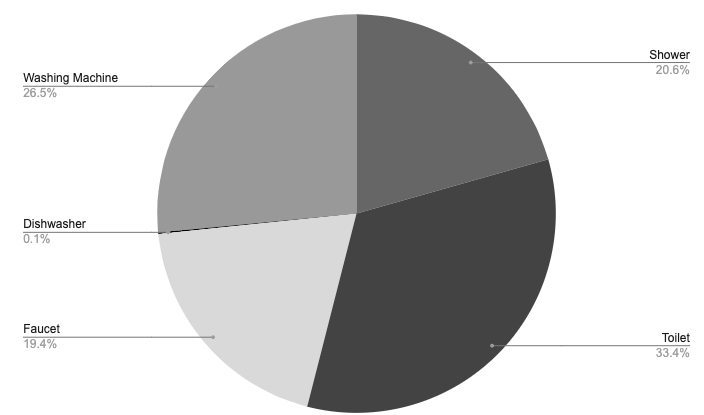
graph by Charlotte King
You may not think twice about running your water while brushing your teeth, putting your clothes on extra wash, or flushing the toilet, but the impact your water usage has is more serious than you think. Our water footprint feels difficult to comprehend, a far-off concept that, because others are the ones who tend to deal with it and feel the impact, is hard to visualize. To help digest these complex numbers we can measure our footprint online through a water footprint calculator.
The average American uses a total of around 1,150 gallons of water per day. Around one-
third of that is household use such as showering, washing dishes, flushing the toilet. The other two-thirds is due to the food and agriculture industries.
According to High Tide Technologies, the agricultural industry is responsible for around 70% of water consumed in the U.S. We can see this reflected in our daily diets. “My personal water footprint is 963 gallons a day, but my diet contributes 571 gallons a day,” said Amelia Fortgang ’22, leader of the Bay Area Youth Climate Summit and co-leader of the environmental club.
Thankfully, our diet, among many others things, are impacts we can control.
Saving water and using less per person leaves more water to return to the ecosystem to sustain and rebuild the environment — and allows water to reach those who do not now have fresh running water.
Reducing water usage also creates a more stable and balanced ecosystem, reducing the likelihood of extreme weather changes and events.
Saving water improves our health and saves lives.
Not only does the direct reduction of water usage help save water, but it also affects our carbon footprint. “The energy needed to move, treat, and use water in the US for both residential and commercial purposes produces nearly 290 million metric tonnes of CO2 annually – the equivalent of 5% of the nation’s overall carbon emissions” wrote Christine Ro, a writer for the BBC, in an article discussing daily water usage. The less water you use, the less water is being transported, and the less CO2 is produced.
Ways to save water:
1. Greywater
Greywater comes from the water used to wash dishes, run the clothes washing machine or dishwasher, bathe, and cook. This water can be used to water houseplants by collecting it with buckets while washing dishes or taking showers. You can also install a greywater system. If you choose to water plants with grey water, be sure to use eco-friendly soaps.
2. Thrifting
Clothes are not the first commodity that people think of when considering water usage. Despite this, clothes are extremely water-intensive to produce. According to the World Wildlife Fund, a T-shirt requires 2,700 liters of water to produce and according to Business Line, the average pair of jeans requires 7,600 liters. Thrifting is a well-known, efficient and affordable solution to this problem. When thrifting, we not only reduce environmental impact by buying recycled clothing and goods, we consequently will not need to buy new clothing that requires water to make.
3. Eat less water-intensive foods
Many foods, such as chocolate, eggs and meat, require large amounts of water to produce. Going vegetarian or vegan has become more widespread as the concern for a variety of responses including environmental ones. Although completely eradicating meat from one’s diet is the most beneficial dietary change for the environment, reducing the amount of meat one eats in general can also make a large impact.
According to Nature’s Sunshine, the average American eats around 110 pounds of red meat per year. Not eating red meat would reduce water consumption by 198,000 gallons of water per year, if based on the FoodTank statistic of 1 pound of red meat requiring 1,800 gallons of water. Chocolate and eggs are also alarmingly water-intensive. According to Huffpost, a single chocolate bar requires 200 gallons and according to Quartz, a sole egg takes around 53 gallons to produce. These foods, like meat, can be difficult to leave behind, but simply becoming more conscious of what we are eating, and how many water-intensive ingredients we use, is a step in the right direction.
4. Direct water usage
Taking shorter showers, turning off the faucet when not using flowing water (such as while brushing your teeth, scrubbing your hands), or flushing the toilet only when necessary are simple and easy ways to reduce one’s water consumption. According to Aquasana, the average American uses 57 gallons of water per day from the toilet, shower, faucet, and washing and dishwashing machines. Another way to save water from direct water usage is to keep a water bottle filled in the fridge for drinking cold water. This way, when you go to fill up a cup with cold water you don’t have to run the water until it is cold.
5. Mindful Watering
Those of us who have yards, maintain our yard’s landscaping by watering. It’s important to water only when needed, properly and only at the right times of the day. On average, according to The University of Utah, the average American uses 100 gallons on yards and landscaping per day. Watering one’s lawn deeply, rather with a light mist for short time periods, is more beneficial to the lawn, because it reaches the roots more efficiently and less water is evaporated. Watering during the coolest times of the day also reduces the water consumption of one’s yard because the water is less likely to evaporate.
6. Talk to your family
If your family is up for it, there are many long-term solutions to reducing water usage that you can implement in your family home! Some include water-efficient faucets and shower heads, replanting your garden with drought resistant or less water-intensive plants, buying higher efficiency washing and dishwashing machines, and installing rain barrels. While some of these can be costly, there are programs that supply water-efficient shower heads at low to no cost. The Cash for Grass program is a rebate program that will replace an older, water-intensive garden or yard with a more water-efficient one.
7. Contact Politicians or Community Leaders
Although we can impact in water usage from small shifts in our daily lives, there is only so much we can do on our own. It is important to hold our government officials accountable. Reach out to your local leader. Call your city councils, board of supervisors, state and national legislators to advocate for a healthier, and more efficient lifestyle — voice your concerns!
Climate change and water conservation may seem daunting but by taking actionable steps using our interests and strengths, we can minimize our environmental footprint. Often, we forget about the impacts that our actions have, not only on the environment, but also on other communities worldwide. “Americans often view the world as something that exists for our benefit. This leads to a lot of abuse of our natural resources, water being one of them,” said Fortgang. By learning about our water footprint we become more conscious of these biases and self-centered motives we, as Americans, have, “You need to be grateful for the basic things that are keeping you alive,” said Shima Konishi-Gray ’23.






